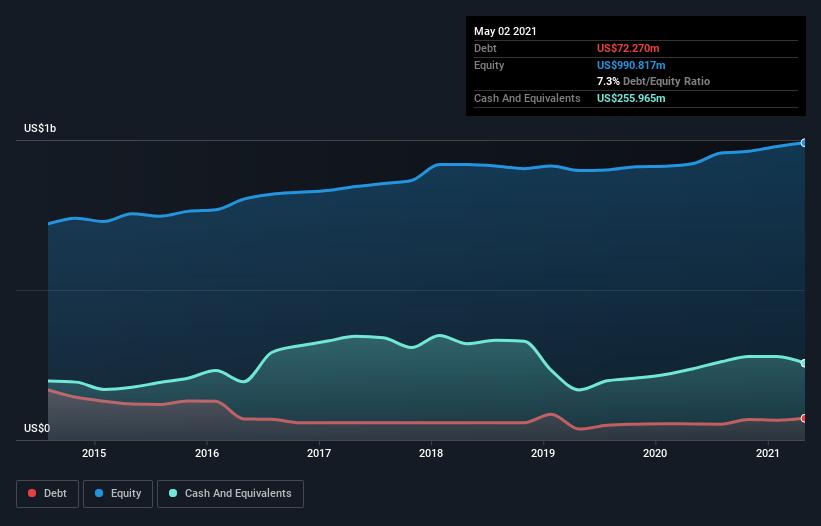Is Photronics (NASDAQ:PLAB) Using Too Much Debt?
Some say volatility, rather than debt, is the best way to think about risk as an investor, but Warren Buffett famously said that 'Volatility is far from synonymous with risk.' So it seems the smart money knows that debt - which is usually involved in bankruptcies - is a very important factor, when you assess how risky a company is. We note that Photronics, Inc. (NASDAQ:PLAB) does have debt on its balance sheet. But should shareholders be worried about its use of debt?
When Is Debt Dangerous?
Debt and other liabilities become risky for a business when it cannot easily fulfill those obligations, either with free cash flow or by raising capital at an attractive price. Ultimately, if the company can't fulfill its legal obligations to repay debt, shareholders could walk away with nothing. However, a more frequent (but still costly) occurrence is where a company must issue shares at bargain-basement prices, permanently diluting shareholders, just to shore up its balance sheet. Having said that, the most common situation is where a company manages its debt reasonably well - and to its own advantage. When we examine debt levels, we first consider both cash and debt levels, together.
Check out our latest analysis for Photronics
How Much Debt Does Photronics Carry?
The image below, which you can click on for greater detail, shows that at May 2021 Photronics had debt of US$72.3m, up from US$53.5m in one year. But on the other hand it also has US$256.0m in cash, leading to a US$183.7m net cash position.
How Strong Is Photronics' Balance Sheet?
According to the last reported balance sheet, Photronics had liabilities of US$159.3m due within 12 months, and liabilities of US$115.9m due beyond 12 months. Offsetting these obligations, it had cash of US$256.0m as well as receivables valued at US$151.5m due within 12 months. So it can boast US$132.3m more liquid assets than total liabilities.
This excess liquidity suggests that Photronics is taking a careful approach to debt. Because it has plenty of assets, it is unlikely to have trouble with its lenders. Simply put, the fact that Photronics has more cash than debt is arguably a good indication that it can manage its debt safely.
Fortunately, Photronics grew its EBIT by 5.7% in the last year, making that debt load look even more manageable. There's no doubt that we learn most about debt from the balance sheet. But ultimately the future profitability of the business will decide if Photronics can strengthen its balance sheet over time. So if you're focused on the future you can check out this free report showing analyst profit forecasts.
But our final consideration is also important, because a company cannot pay debt with paper profits; it needs cold hard cash. While Photronics has net cash on its balance sheet, it's still worth taking a look at its ability to convert earnings before interest and tax (EBIT) to free cash flow, to help us understand how quickly it is building (or eroding) that cash balance. Considering the last three years, Photronics actually recorded a cash outflow, overall. Debt is usually more expensive, and almost always more risky in the hands of a company with negative free cash flow. Shareholders ought to hope for an improvement.
Summing up
While it is always sensible to investigate a company's debt, in this case Photronics has US$183.7m in net cash and a decent-looking balance sheet. And it also grew its EBIT by 5.7% over the last year. So we don't have any problem with Photronics's use of debt. Of course, we wouldn't say no to the extra confidence that we'd gain if we knew that Photronics insiders have been buying shares: if you're on the same wavelength, you can find out if insiders are buying by clicking this link.
Of course, if you're the type of investor who prefers buying stocks without the burden of debt, then don't hesitate to discover our exclusive list of net cash growth stocks, today.
This article by Simply Wall St is general in nature. It does not constitute a recommendation to buy or sell any stock, and does not take account of your objectives, or your financial situation. We aim to bring you long-term focused analysis driven by fundamental data. Note that our analysis may not factor in the latest price-sensitive company announcements or qualitative material. Simply Wall St has no position in any stocks mentioned.
Have feedback on this article? Concerned about the content? Get in touch with us directly. Alternatively, email editorial-team (at) simplywallst.com.

